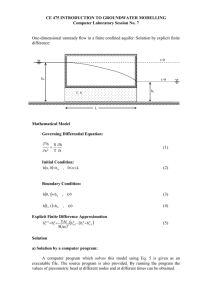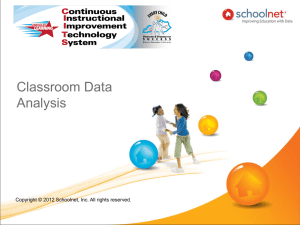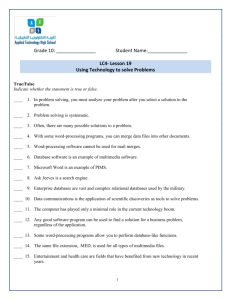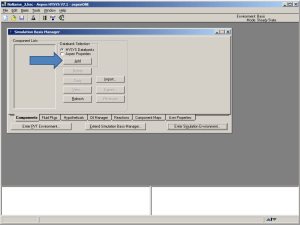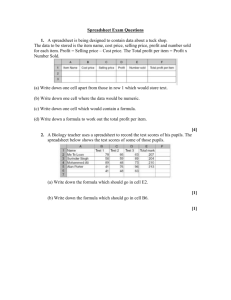Chapter 12 Exercises and Answers
advertisement
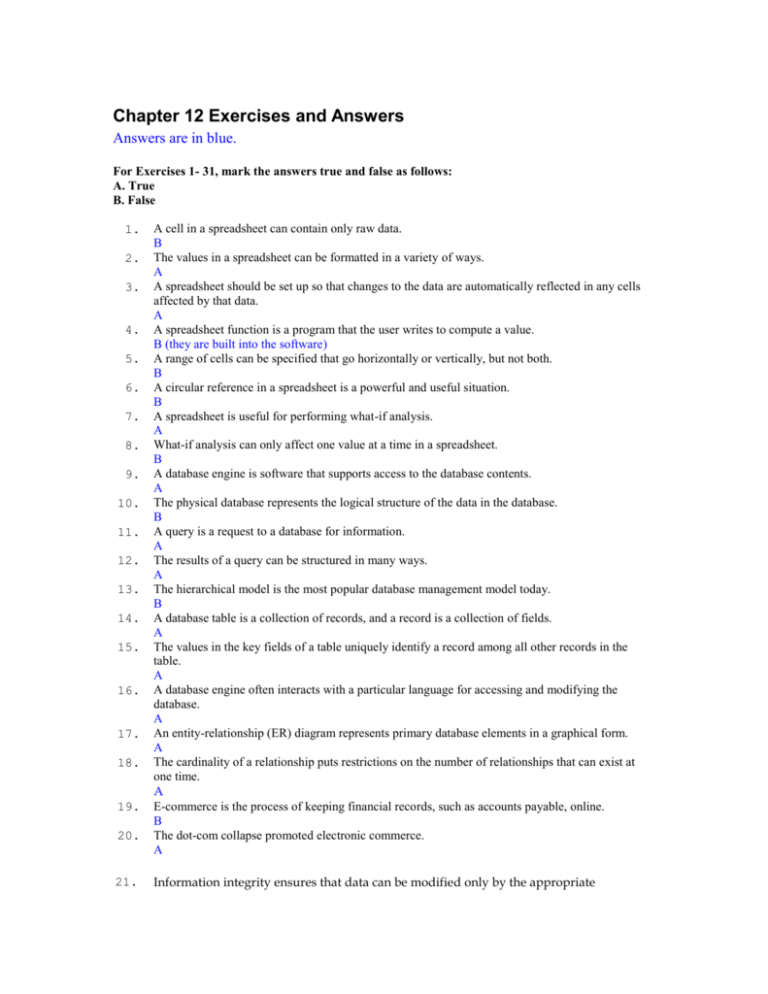
Chapter 12 Exercises and Answers Answers are in blue. For Exercises 1- 31, mark the answers true and false as follows: A. True B. False 1. 2. 3. 4. 5. 6. 7. 8. 9. 10. 11. 12. 13. 14. 15. 16. 17. 18. 19. 20. 21. A cell in a spreadsheet can contain only raw data. B The values in a spreadsheet can be formatted in a variety of ways. A A spreadsheet should be set up so that changes to the data are automatically reflected in any cells affected by that data. A A spreadsheet function is a program that the user writes to compute a value. B (they are built into the software) A range of cells can be specified that go horizontally or vertically, but not both. B A circular reference in a spreadsheet is a powerful and useful situation. B A spreadsheet is useful for performing what-if analysis. A What-if analysis can only affect one value at a time in a spreadsheet. B A database engine is software that supports access to the database contents. A The physical database represents the logical structure of the data in the database. B A query is a request to a database for information. A The results of a query can be structured in many ways. A The hierarchical model is the most popular database management model today. B A database table is a collection of records, and a record is a collection of fields. A The values in the key fields of a table uniquely identify a record among all other records in the table. A A database engine often interacts with a particular language for accessing and modifying the database. A An entity-relationship (ER) diagram represents primary database elements in a graphical form. A The cardinality of a relationship puts restrictions on the number of relationships that can exist at one time. A E-commerce is the process of keeping financial records, such as accounts payable, online. B The dot-com collapse promoted electronic commerce. A Information integrity ensures that data can be modified only by the appropriate mechanisms. A 22. Pairing threats with vulnerabilities is a part of risk analysis. A 23. Decryption is the process of converting plaintext into ciphertext. B A transposition cipher is an example of modern cryptography that is difficult for a computer to break. B 25. A digital signature allows the recipient to verify that the message truly originates from the stated sender. A 26. Using biometrics is one of the most expensive ways to collect authentication credentials. A 27. A computer virus “infects” another program by embedding itself into it. A 28. A logic bomb is set to go off when a particular system event occurs, such as a particular date and time. A 29. Phishing is a form of password guessing. B 30. A back door threat is implemented by a programmer of the system under attack. A 31. A denial of service attack does not directly corrupt data. A For Exercises 32 - 36, match the solution to the question using the spreadsheet shown. A. dynamic B. function C. circular D. range E. schema F. field 24. 32. 33. 34. 35. 36. A spreadsheet is ____ in that it responds to changes in the data by immediately updating all affected values. A A spreadsheet formula may operate on a ____ of cells, such as C4..C18. D The database ____ is the specification of the logical structure of the data in the database. E A ____ reference occurs when the result of one formula is ultimately based on another, and vice versa. C A ____ contains a single data value. F Exercises 37-87 are problems or short answer questions. Use the following spreadsheet that contains student grades for Exercises 37-45. A B C D E F G 1 Grades 2 Exam 1 Exam 2 Exam 3 Average 3 4 Bill 89 33 80 67.3333 5 6 7 8 9 10 11 12 13 14 15 16 37. 38. 39. 40. 41. 42. 43. 44. 45. 46. 47. 48. 49. Students Total Average Bob Chris Jim Judy June Mari Mary Phil Sarah Susy 90 50 75 66 60 70 50 75 77 80 80 80 83 84 85 87 89 90 99 98 90 89 90 85 75 90 85 85 90 95 893 839 912 81.1818 76.2727 82.9090 71.6666 65.3333 67.3333 80 84 88.6666 95.6666 88 83.3333 90 881.333 80.1212 Specify the grades for Exam 2. E4..E14 Specify the average for Exam 1. D15 Specify the average for Sarah. G13 Specify the third exam grade for Mari. F10 Specify the exam grades for Susy. D14..F14 What formula is stored in F15? SUM(F4..F14) D16 contains the formula D15/COUNT(D4..D14). What is another formula that would yield the same value? AVERAGE(D4..D14) Which formula is stored in E13? There isn't a formula stored there; it is a single value. What values in what cells would change if Phil's exam 2 score was corrected to 87? F12, F15, F16, G12, G15 What is a spreadsheet circular reference? Why is it a problem? A circular reference is one in which two or more formulas depend upon each other. For example, F5 may use D4 in its calculation, and D4 may use F5 in its calculation. A circular reference may be direct as in the F5, D4 example or indirect involving many different formulas. The problem is that the calculation can not be made because of the interdependence of the references. Give a specific example of an indirect circular reference similar to the one shown in Figure 12.5. B1 = SUM(A1..A5) * C2 C2 = SUM(B5..B12) B8 = G1 - D2 D2 = G3 * B1 B1 depends on C2; C2 depends on B8; B8 depends on D2; and D2 depends on B1. What is what-if analysis? The values representing assumptions in a spreadsheet can be changed and the effects on related data can be observed. This varying of values and the observation of the results represent what-if analysis. That is, you can ask what happens if you change certain values and see the results. Name some what-if analysis questions that you might ask if you were using a spreadsheet to plan and track some stock purchases. Explain how you might set up a spreadsheet to help answer those questions. We are considering buying stock in four Fortune Five Hundred companies. What would my gain be if all four of the stocks gained 6% over a year? What would my gain be if two gained 6% over a year, but the other two lost 2%? What would my loss be if all four lost 2%? All of these percentages could be varied and the results examined. The spreadsheet could be set up with the stock names in B2..B5, the initial prices in C2..C5, the calculated prices based on percentage gains or losses per stock in D2..D5. C6 could contain the formula for summing C2..C5. D6 could contain the formula for summing D2..D5. E6 could contain the formula for subtracting C6 from D6 to calculate the gain or loss. For questions 50 through 53, use the paper spreadsheet form supplied on the textbook’s web site or use an actual spreadsheet application program to design the spreadsheets. Your instructor may provide more specific instructions regarding these questions. 50. 51. 52. 53. 54. 55. 56. 57. 58. 59. 60. 61. 62. 63. 64. These are activities for which there are no specific answers. Design a spreadsheet to track the statistics of your favorite major league baseball team. Include data regarding runs, hits, errors, and runs-batted-in (RBIs). Compute appropriate statistics for individual players and the team as a whole. Design a spreadsheet to maintain a grade sheet for a set of students. Include tests and projects, given various weights to each in the calculation of the final grade for each student. Compute the average grade per test and project for the whole class. Assume you are going on a business trip. Design a spreadsheet to keep track of your expenses and create a summary of your totals. Include various aspects of travel such as car mileage, flight costs, hotel costs, and miscellaneous (such as taxis and tips). Design a spreadsheet to estimate and then keep track of a particular project’s activities. List the activities, the estimated and actual dates for those activities, and schedule slippage or gain. Add other data as appropriate for your project. Compare a database with a database management system. A database is a structured set of data. A database management system is a software system made up of the database, a database engine (for manipulating the database), and a database schema that provides the logical view of the database. What is a database schema? A database schema is the specification of the logical structure of a database. Describe the general organization of a relational database. A relational database is organized around the concept of a table. Both data and relationships are represented in tables. What is a field (attribute) in a database? A field is a single value in a database record. A field represents one aspect or attribute of the item in a database. Which other fields (attributes) might we include in the database table of Figure 12.7? There are four fields in the table in Figure 12.7 that describe a movie: MovieID, Title, Genre, and Rating. Additional items might be Director, MaleLead, FemaleLead, Producer, and Date. Which other fields (attributes) might we include in the database table of Figure 12.8? There are four fields in the table in Figure 12.8 that describe a customer: CustomerID, Name, Address, and CreditCardNumber. Additional items might be PhoneNumber, HighestRatingAcceptable, and MaxMovies. What is a key in a relational database table? In a relational database, every record in a table must be uniquely identified. The field or combination of fields that are used to uniquely identify records in a table is called the key field. Specify the schema for the database table of Figure 12.8. Customer(CustomerId, Name, Address, CreditCardNumber) How are relationships represented in a relational database? In a table, of course! A table is created that represents the relationship. Usually, the keys of both items in the relationships are represented as fields in the relationship table, along with appropriate information about the relationship. Define an SQL query that returns all attributes of all records in the Customer table. select * from Customer Define an SQL query that returns the movie MovieId and title of all movies that have an R rating. select MovieId, Title from Movie where Rating = 'R' 65. Define an SQL query that returns the address of every customer in the Customer table that lives on Lois Lane. select Address from Customer where Address like ‘%Lois Lane%’ Define an SQL statement that inserts the movie Armageddon into the Movie table. insert into Movie values(1433, Armageddon, action sci-fi, R) Define an SQL statement that changes the address of Amy Stevens in the Customer table. update Customer set Address = '333 Silver Way' where Name = 'Amy Stevens' Define an SQL statement that deletes the customer with a CustomerId of 103. delete from Customer where CustomerId = 103 What is an ER diagram? An ER diagram is a graphical representation of an Entity-relationship model, which is a technique for design relational databases. How are entities and relationships represented in an ER diagram? In an ER diagram, tables are represented by rectangles and diamonds represents relationships. How are attributes represented in an ER diagram? Attributes are represented in ovals with lines connecting them to the entity they describe. What are cardinality constraints and how are they shown in ER diagrams? Cardinality constraints are the number of relationships that can exist between entities in an ER diagram. They are represented by the number 1 and the letter M (for Many). These values are written on the line connecting the table and the relationship. What are the three general cardinality constraints? One to one, one to many, and many to many. Design a database that stores data about the books in a library, the students that use them, and the ability to check out books for a period of time. Create an ER diagram and sample tables. 66. 67. 68. 69. 70. 71. 72. 73. 74. Name Title 11 Students IdNum M ChecksOut PhonNo No Books Author Students IdNum Name PhonNo 223456789 Sally Silent 232-4432 432543654 Lottie Loud 343-3321 898978675 Maud Middle 454-3452 Books IdNum Author Title 443233 Brown Fly Fishing in the Sahara 567622 Smith Dust Storms in the Amazon Basin IdNum m 657687 Anderson Skating on Thin Ice ChecksOut IdNum IdNum DateDue 443233 Brown 10/23/2004 567622 Smith 10/30/2004 657687 Anderson 11/1/2004 75. Design a database that stores data about the courses taught at a university, the professors that teach those courses, and the students that take those courses. Create an ER diagram and sample tables. Name Students IdNum Title 11 Takes M PhonNo No IdNum m Name Faculty IdNum Title 11 Teaches 223456789 Name Sally Silent M Classes IdNum m PhonNo No Students IdNum Classes PhonNo 232-4432 432543654 Lottie Loud 343-3321 898978675 Maud Middle 454-3452 Faculty IdNum Name PhonNo 344567777 Abby Absent 632-4432 222222222 Steven Stern 373-3321 434343434 Mary Modern 453-3452 Courses IdNum Title CS304 Introduction to CS CS328 Abstract Data Types CS375 Compiler Design 76. 77. 78. 79. 80. 81. 82. 83. 84. 85. What were some of the web-based technologies that allowed e-commerce to become viable? E-commerce became viable through the evolution of online store fronts (such as Amazon), electronic shopping carts, and online payment systems (such as PayPal). What is the CIA triad of information security? The CIA triad is a way to remember the three primary aspects of information security: confidentiality, ensuring that key data is protected from unauthorized access, integrity, ensuring that data can only be modified using appropriate mechanisms, and availability, ensuring that authorized users can access appropriate information for legitimate purposes. Other than those presented in this chapter, give three examples of data integrity violations. Three examples of data integrity violations: (1) a hacker breaking into a restaurant’s computer to learn your credit card number, (2) a system manager for a restaurant using his access to learn your credit card number, and (3) network problems causing your credit card number to be inaccurately conveyed during an online transaction. Using a Caesar cipher, shifting 3 letters to the right, encrypt the message “WE ESCAPE TONIGHT”. Encrypted message: ZH HVFDSH WRQLJKW Using the Caesar cipher described in this chapter, decrypt the message “WJNSKTWHJRJSYX FWWNAJ RTSIFD”. Decrypted message: REINFORCEMENTS ARRIVE MONDAY Using the same transposition cipher technique used in this chapter, encrypt the message “WHO IS THE TRAITOR”. Encrypted message: TORITTOHWIHRAES Describe how Claire would send a message to David using public-key encryption. Claire obtains David’s public key, which is available to anyone who wants it, and uses it to encrypt the message. She then sends the message to David, who uses his private key to decrypt the message. What are the three general approaches to presenting authorization credentials? Authorization credentials are generally provided by (1) usernames and passwords, (2) a physical item the user carries such as a machine-readable identification card or smart card, or (3) biometrics, such as fingerprint or retina pattern recognition. Describe how a Trojan horse attacks a computer system. A Trojan horse attacks a system by masquerading as a benign or helpful program, when in fact it is harmful. Unsuspecting users often download and execute such programs deliberately. Describe a hypothetical scenario, other than the one described in this chapter, of a phishing attack. 86. 8. An example of a phishing attack: You receive an email, supposedly from Facebook, that indicates a problem with your account. The email provides a link for you to follow to address the problem. The email and link look authentic, but actually direct you to a malicious site. The page requests that you log into your Facebook account, then transmits that data to hackers who gain inappropriate access to your account. How might a buffer overflow make a computer system vulnerable? If a program is not written carefully enough, a hacker can cause an overflow buffer to occur, perhaps by filling an input field with too much data, and causing the program to crash. Such problems can leave the user with access to the underlying system, and with inappropriately high levels of functionality. How does a man-in-the-middle attack work? A man-in-the-middle attack is perpetrated by someone along a network communication line that has access to the flow of network traffic. That person uses programs to watch for data that might be interesting, such as passwords being transmitted as part of an email message. Encryption is usually a good defense against such attacks, because even if a message is intercepted, it cannot be decrypted.



